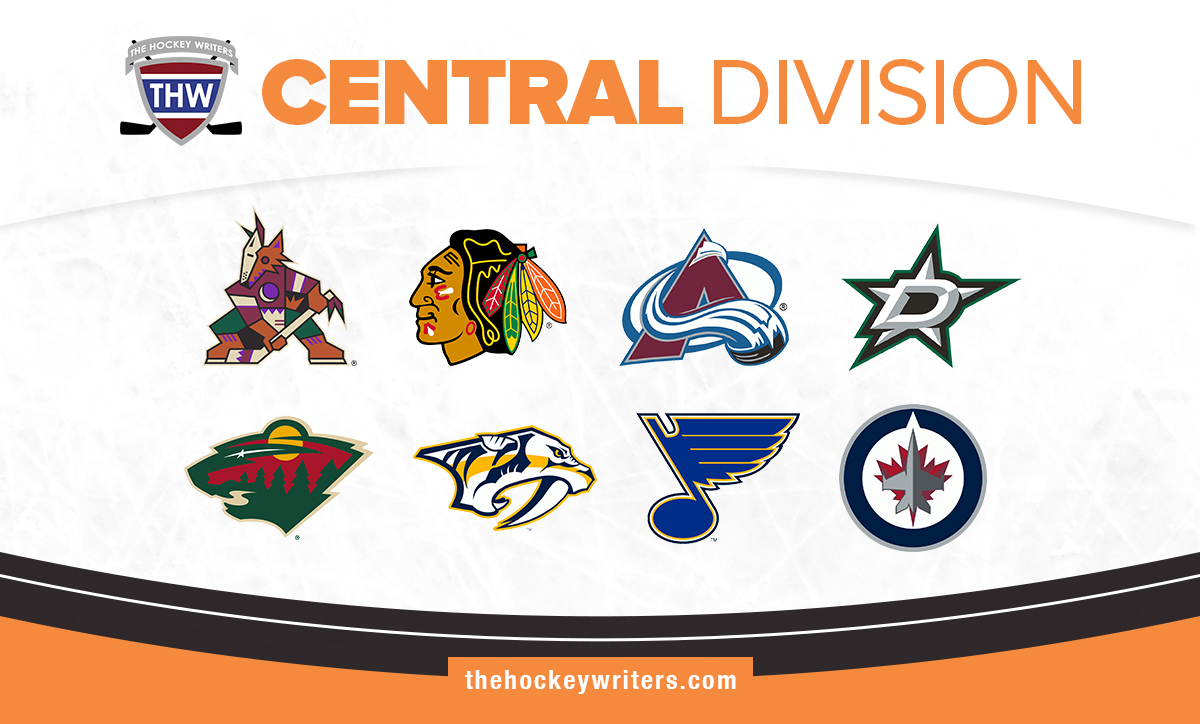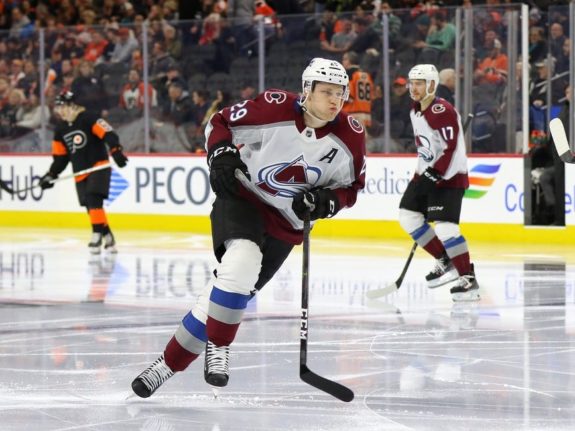The Colorado Avalanche are prohibitive favorites to win the NHL’s Central Division, and despite last season’s early exit from the playoffs, are a slight favorite to win the Stanley Cup. While there are on-ice questions that come with the start of any season — can Nathan MacKinnon carry his stellar play all the way through the playoffs; will goaltender Darcy Kuemper perform at a high enough level to support his new team — there are longer-term questions off the ice that will need to be answered.
Consider the contracts of several key players: Kuemper, fellow netminder Pavel Francouz, center Nazem Kadri, left wing Andre Burakovsky, and right wing Valeri Nichushkin, are each in the final year of their respective deals. MacKinnon’s current contract, perhaps the best bargain in the NHL, expires at the end of next season. As general manager Joe Sakic looks to the future, he will have his hands full navigating the league’s salary cap, trying to maintain the high level of play the team has enjoyed over the last few seasons.
Understanding the Salary Cap
The NHL salary cap, and the rules that surround it, can seem opaque at best to casual fans. But understanding a few key concepts can make it much more accessible. (If you’re familiar with how the cap and contracts work, you might want to skip to the next section.)
- Each team’s total payroll for rostered players cannot exceed $81.5M for the upcoming season and not more than $82.5M next season. There are exceptions – for example, you can exceed the cap if you have a player on the Long Term Injured Reserve (LTIR) list — but it’s not necessary to grasp those details to grok the big picture.
- No individual player can sign a contract longer than eight years, nor can he make more than 20 percent of the cap. In the 2021-22 season, that number is $16.3M. (No player in the league actually makes that much, though a few are close.)
- No matter how a contract is written, it is the average annual value (AAV) of a contract that matters for salary cap purposes. For example, a player may sign a three-year deal in which he earns $10M in year one, $7.5M in year two, and $5M in year three. For the cap, that contract is worth $7.5M in each of the three years. Simply take the total value of the contract and divide it by the total length of the contract. This stops teams from front-loading long-term deals (paying more in the first year than in the last year of the contract) to gain cap space in the future.
- Signing and performance bonuses count toward a team’s cap. There is special math in each circumstance that isn’t worth worrying about. (For example, signing bonuses are prorated.)
- While $81.5M is the upper limit of the cap, there is a lower limit, too. Teams cannot spend less than $16M below the upper limit. In other words, every team must spend at least $65.5M on player payroll.
- The term “cap space” refers to the amount of money a team is able to spend before hitting the cap.
Avalanche Strength in the Central Division
When comparing the Avalanche to the rest of the Central Division, a few things jump out. First, Colorado is spending more on defense ($28.62 million this year) than any other team. The Minnesota Wild ($28.58 million) and Winnipeg Jets ($27.1 million) come close, but then it’s more than a $2 million gap to the next closest team, the Dallas Stars. (The Arizona Coyotes are spending only $18.4 million on defense.) In fact, the Avalanche defense has the second-highest AAV in the entire league, eclipsed only by the San Jose Sharks. This disparity is a window into the approach used by Sakic. If pitching and defense win baseball games, especially in the postseason, then goaltending and defense wins hockey games.

Conversely, the Avalanche are third from the bottom in salaries for offensive players ($44.1 million), with only the Nashville Predators ($41.0 million) and Minnesota Wild ($41.5 million) spending less. The Avalanche also have the fourth-highest cap space ($1.5 million) in the division. The Coyotes, who will lose almost their entire roster to free agency next year and are clearly in rebuilding mode, have $11 million in cap space; the Predators, who will also feel the impact of free agency in the 2022-23 season, have cap space of $10.4 million. It’s likely we’ll see both of those teams very active in the trade market this season, and in the free-agent market next summer. That the Avalanche can have cap space and still be a division leader is a testament to good management.
Core Avalanche Players Locked In
With all this in mind, let’s start with the good news regarding player contracts for Colorado. Mikko Rantanen and Gabriel Landeskog, MacKinnon’s linemates on the team’s number one line — one of the best lines in all of hockey — are both locked in for several years. Rantanen, who would be the number one star on almost any other team in the league, is under contract through the 2024-25 season. The average annual value (AAV) of his contract is $9.25 million, making him the highest-paid player on the Avalanche. Landeskog, the team’s captain, signed an eight-year deal this summer at an AAV of $7 million. That price tag represents what many consider to be a modest hometown discount. Landeskog made it known that he wanted to stay in Denver and was willing to work with the team to get a fair contract.
“I grew up with posters of the Av’s Cup-winning teams in ’96 and ’01 in my room,” Landeskog said after signing the long-term deal. “And that was my goal, my dream, to be in a picture wearing an Av’s jersey and holding the Stanley Cup.”
The Avalanche also locked down defenseman Cale Makar with a contract this off-season worth $54 million over six years, or a cap hit of $9 million per year. In fact, the core defensive unit is solidly in place for at least a couple of seasons: Sam Girard is under contract through 2026-27 at an AAV of $5 million, Devon Toews is under contract through 2023-24 at an AAV of $4.1 million, and veteran Erik Johnson’s deal runs through the end of next season at an AAV of $6 million. Johnson’s age and inability to stay healthy will likely make him expendable, especially with Bowen Byram joining the club full time this season. It’s possible Sakic will attempt to extract value for Johnson and put him on the trading block before the year is out.
Big Questions for Colorado
With the defense in hand, Sakic has three big questions to answer: Nathan MacKinnon, the second line of the offense, and goaltending.
First, and most importantly to Avalanche fans, is MacKinnon. Widely considered a top-three player in the league, MacKinnon will command big money when he and the Avalanche sit down at the negotiating table next year. His agent will make the case that MacKinnon is worth at least the same as the Edmonton Oilers’ Connor McDavid ($12.5 million AAV), the Toronto Maple Leafs’ Austin Matthews ($11.64 million AAV) and the New York Rangers’ Artemi Panarin ($11.64 million AAV). And with inflation and a rising cap, MacKinnon and his representatives could comfortably make the case he should earn more.
But like Landeskog, MacKinnon has signaled his willingness to work with the Avalanche to find a fair deal that will keep him in Colorado and keep the team competitive.

“We have guys that we wouldn’t (otherwise) be able to bring in,” MacKinnon told Jordan Horrobin of Forbes Magazine. “On my next deal, I’ll take less again. Because I want to win with this group.”
That’s good news for Colorado. MacKinnon’s current AAV is $6.3 million. If Sakic and MacKinnon can agree on a deal in the neighborhood of an $11 million AAV, a salary cap hit of an additional $5 million/year, that will still leave plenty of room in the cap next year when Kuemper, Burakovsky, Kadri, and Nichushkin all become unrestricted free agents (UFAs).
This is where Sakic’s brilliant management of player development over the last five seasons will pay off. From drafting Makar and Byram to trading for talented players at just the right moment — Girard, Brendan Saad, Kadri — Sakic has seemed to fire on all cylinders throughout his tenure as the Avalanche’s GM.
Sakic Has Options
Depending on how the core of strong young players — Byram, Alex Newhook, Sampo Ranta, Shane Bowers, Oskar Olausson — performs this season, Sakic may find himself with ample cap space to either re-sign Kuemper or go on the open market to find a top-flight goaltender. The team will also get back $2 million in cap space if they don’t re-sign Francouz and instead develop one of their young goalies — Jonas Johansson, Hunter Miska, or Justus Annunen — as a reliable backup at a lower price tag. Even with this, there will be money left to retain two of the three UFAs, (Burakovsky, Kadri, Nichushkin) or head to the trade and free agency markets to build a supporting cast behind the top line.
As the complexion of the team hinges on the MacKinnon contract, look for Sakic to get that deal done early, possibly before the end of the current campaign. Once his star is locked in, the rest of the pieces will fall into place relatively easily. Even if the Avalanche fail in their quest for the Stanley Cup this season, thanks to astute handling of the team’s contracts, salary cap, and farm system, expect Colorado to be contenders for several years to come.
The Avalanche open their season at home versus the improving Chicago Blackhawks on Wednesday, Oct. 13.